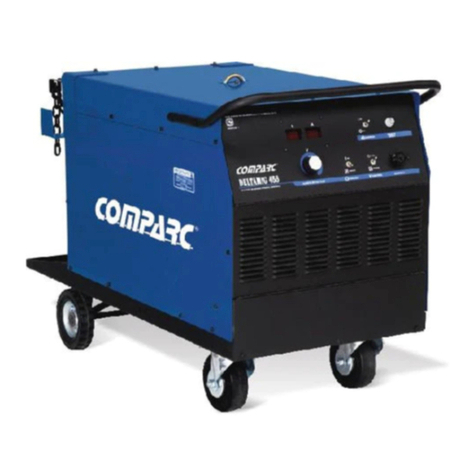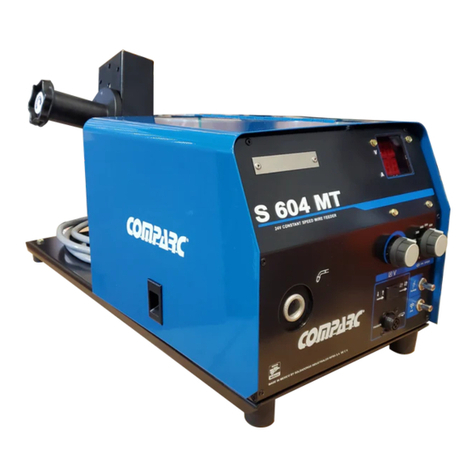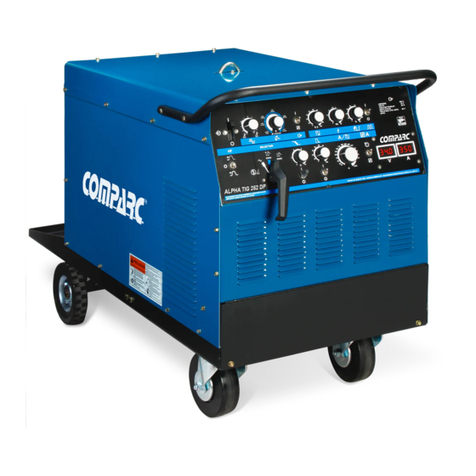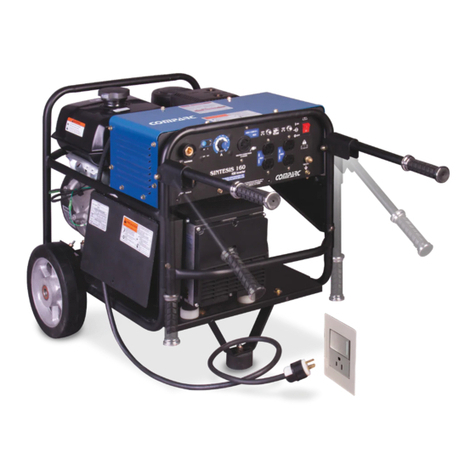
iii
CONSIGNES DE SÉCURITÉ POUR LE SOUDAGE À L’ARC
MISE EN GARDE
SE PROTÉGER ET PROTÉGER LESAUTRES CONTRE LES BLESSURES GRAVES VOIRE MORTELLES. TENIR LES ENFANTS ÀL’ÉCRT. LES PERSONNES
QUIPQRTENTUNSTIMULATEURCARDIAQUENEDOIVENTPASNONPLUSS’APPROCHERDUPOSTEDESOUDAGE,AMOINSD’AVOIRCONSULTUNMÉDECIN.
Le soudage, comme la plupart des travaux, présente certains dangers. Par contre, le soudage peut être effectué en toute sécurité quand on prend les mesures
qui s’imposent. Les consignes de sécurite données ci-après ne font que résumer I’information contenue dans les normes de sécurité énumérées à la page
suivante. Lire et respecter toutes ces normes de sécurité.
L’INSTALLATIONL’UTILISATIONL’ENTRETIENETLESRÉPARATIONSNEDOIVENTÊTRECONFIÉSQU’ÀDESPERSONNESQUALIFIÉES.
UNCHOCÉLECTRIQUEpeuttuer.
Unsimple contact avecdes pieces lectriques peut provoquer
une electrocution ou des blessures graves. L’électrode et
le circuit de soudage sont sous tensiuon dès que I’appareil
est sur ON. Le circuit d’entrée et les circuits intemes de
I’appareil sont également sous tension à ce moment-là. En
soudagesemi-automatiqueouautomatique, lefil,ledévidoir,
le logement des galets d’entraînement et les pièces
métalliques en contact avec le fil de soudage sont sous
tension. Des matériels mal installés ou mal mis à la terre
présentent un danger.
1. Ne jamais toucher les pièces électriques sous tension.
2. Porter des gants et des vêtements de protection secs ne comportant
pas de trous.
3. S’isoler de la pièce et de la terre au moyen de tapis ou d’autres moyens
isolants suffisamment grands pour empêcher le contact physique
éventuel avec la pièce ou la terre.
4. CouperI’alimentationouarrêter lemoteuravantdeprocéderàI’installation,
à la réparation ou à I’entretien de I’appareil.
Déverrouiller I’alimentation selonla norme OSHA29 CFR 1910.147 (voir
normes de sécurité).
5. Installer et mettre à la terre correctement cet appareil conformément à
sonmanuel d’utilisationetaucodes nationaux,provinciauxetmunicipaux.
6. Toujours vérifier la terre du cordon d’alimentation - Vérifier et s’assurer
que le fil de terre du cordon d’alimentation est bien raccordé à la bome
de terre du sectionneur ou que la fiche du cordon est raccordée à une
prise correctement mise à la terre.
7. En effectuant les raccordements d’entrée fixer d’abord le conducteur de
mise à la terre approprié et contre-vérifier les connexions.
8. Vérifier fréquemment le cordon d’alimentation pour voir s’il n’est pas
endommagé ou dénudé - remplacer le cordon immédiatement s’il est
endommagé - un câble dénudé peut provoquer une électrocution.
9. Mettre I’appareil hors tension quand on ne I’utiiise pas.
10. Ne pas utiliser des câbles usés, endommagés, de grosseur insuffisante
ou mal épissés.
11. Ne pas enrouler les câbles autour du corps.
12. Si la pièce soudée doit être mise à la terre, le faire directement avec un
câble distinct -ne pas utiliser le connecteur de pièce ou le câble de retour.
13. Ne pas toucher I’électrode quandon est en contact avec la pièce, la terre
ou une électrode provenant d’une autre machine.
14. N’utiliser qu’un matériel en bonétat. Réparer ouremplacer sur-le-champ
les pièces endommagées. Entretenir I’appareil conformément à ce
manuel.
15. Porter un harnais de sécurité quand on travaille en hauteur.
16. Maintenir solidement en place tous les panneaux et capots.
17. Fixer le câble de retour de façon à obtenir un bon contact métal-métal
avec la pièce à souder ou la table de travail, le plus près possible de la
soudure.
LE RAYONNEMENT DE L’ARC peut brûler les yeux et la
peau.LeBRUITpeut endommager I’ouïe;lesPROJECTIONS
DELAITIEROULESÉTINCELLESpeuventblesserlesyeux.
L’arc de soudage produit des rayons visibles et invisibles
intenses (ultraviolets et infrarouges) qui peuvent brûler les
yeux et la peau. Le bruit produit par certains procédés peut
endommager I’ouïe. Des projections de métal ou de laitier
sontproduitesparlepiquage,lemeulageoulerefroidissement
des soudures.
BRUIT
1. Utiliser des bouche-oreilles ou des serre-tête antibruit approuvés si le
niveau de bruit est élevé.
RAYONNEMENTDEL’ARC
2. Porter un masque à serre-tête muni d’un verre filtrant de nuance
appropriée pour protéger levisage et les yeuxquand on soude ouobserve
la travail de soudage (voir les normes ANSIZ49.1 et Z87.1données sous
la rubrique Principales normes de sécurité).
3. Porter des lunettes de sécurité approuvées avec écrans latéraux.
4. Utiliser des paravents ou des barrières de protection pour protéger les
personnes à proximité contre les coups d’arc et l’eblouissement; avertir
les autres personnes de ne pas regarder I’arc.
5. Porter des vêtements de protection en tissu ignifuge durable (laine et
cuir) et des chaussures de sécurité.
portant un appareil respiratoire à adduction d’air pur. Demander à un
observateur ayant reçu la bonne formation de toujours se tenir à
proximité. Les vapeurs et fumées de soudage peuvent déplacer I’air
et abaisser le niveau d’oxygène et causer des blessures graves voire
mortelles. S’assurer que I’air est propre à la respiration.
6. Ne pas souder à proximité d’opérations de dégraissage, de nettoyage
ou de pulvérisation. La chaleur et les rayons de I’arc peuvent réagir avec
les vapeurs pour former des gaz hautement toxiques et irritants.
7. Ne pas souder sur des métaux revêtus comrne I’acier galvanisé, au
plomb ou cadmié à moins que la pièce n’ait été entièrement décapée,
que le poste de travail soit bien ventilé. S’il y a lieu, porter un appareil
respiratoire à adduction d’air pur. Les revêtements et les métaux qui
contiennent de tels éléments peuvent dégager des vapeurs toxiques lors
du soudage.
LESVAPEURSETLESFUMÉESpeuvent êtredangereuses
pour la santé.
Le soudage produit des vapeurs et des fumées qu’il est
dangereux de respirer.
1. Garder la tête à I’exterieur des vapeurs et des fumées et
ne pas les respirer.
2. A I’intérieur, ventiler le poste de travail ou utiliser un dispositif placé au
niveau de I’arc pour évacuer les vapeurs et fumées de soudage.
3. Si la ventilation est mauvaise, utiliser un appareil respiratoire à adduction
d’air pur approuvé.
4. Consulter les fiches signalétiques et les consignes du fabricant relatives
au métaux, produits d’apport, revêtements, nettoyants et dégraissants.
5. Ne travailler dans un espace confiné que s’il est bien ventilé, ou en
LES BOUTEILLES peuvent exploser si elles sont
endommagées.
Les bouteilles contenant des gaz de protection sont à haute
pression. Une bouteille endommagée peut exploser. Étant
donné que les bouteilles de gaz font normalement partie du
matériel de soudage, les traiter avec le plus grand soin.
1. Protéger les bouteilles de gaz comprimé contre la chaleur intense, les
chocs, le laitier, les flammes nues, les étincelles et I’arc.
2. Placer les bouteilles à la verticale en les fixant à un support fixe ou à
un chariot pour éviter qu’elles ne tombent ou ne basculent.
3. Tenir les bouteilles à I’écart du poste de soudage ou d’autres circuits
électriques.
4. Ne jamais poser un chalumeau soudeur sur une bouteille de gaz.
5. Ne jamais laisser une électrode de soudage toucher une bouteille.
6. Ne jamais souder sur une bouteille sous pression: elle exploserait.
7. N’utiliser que des bouteilles de gaz de protection, des détendeurs, des
tuyaux souples et des raccords appropriés conçus pour I’application
particulière; conserver ces matériels et leurs pièces en bon état.
8. Éloigner le visagede la sortie du robinet de la bouteille quand on I’ouvre.
9. Replacer le chapeau sur la bouteille après utilisation.
10. Lire et suivre les consignes relatives aux bouteilles de gaz comprimé,
au matériel connexe ainsi que la publication P-1 de la CGA donnée sous
la rubrique Principales normes de sécurité.
LE SOUDAGE À L’ARC peut être dangereux.
































